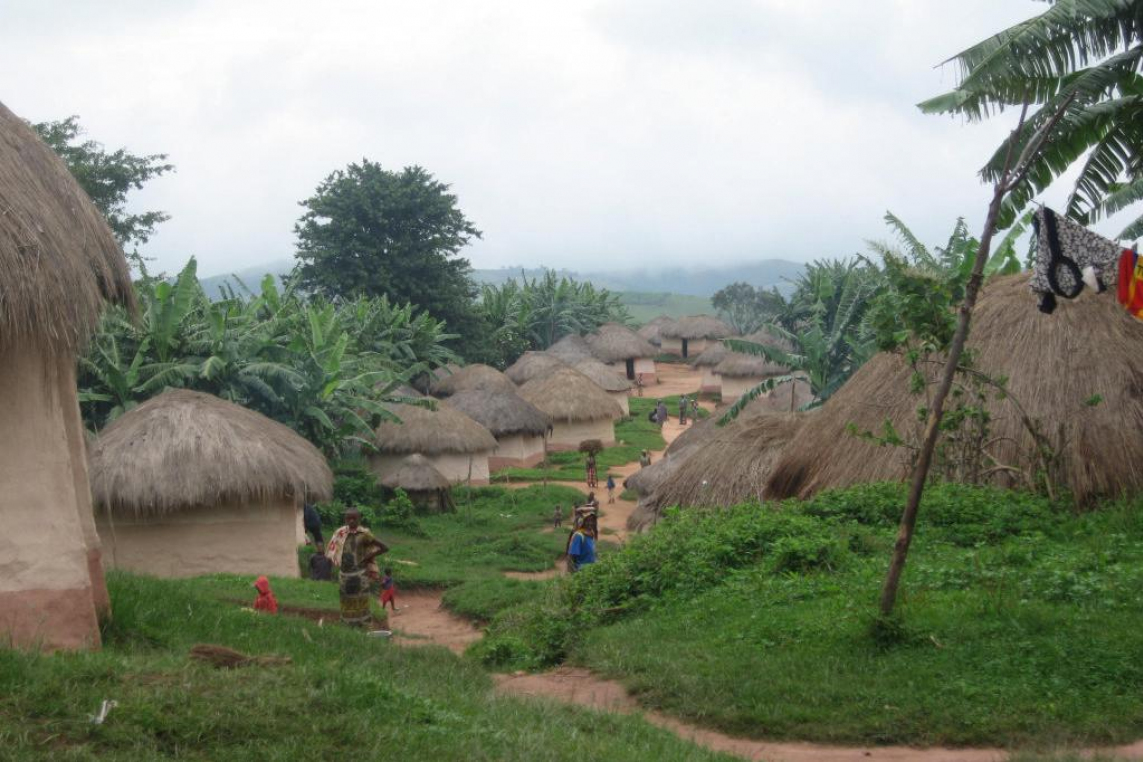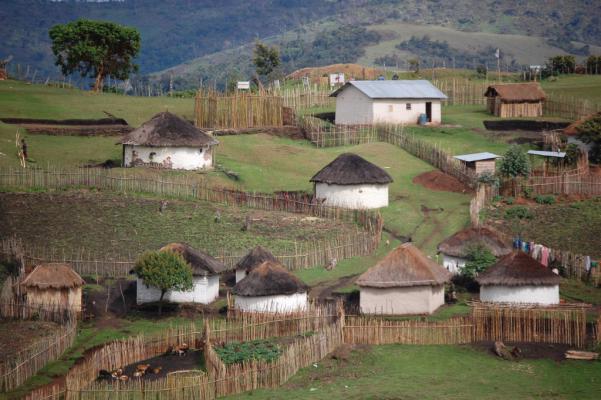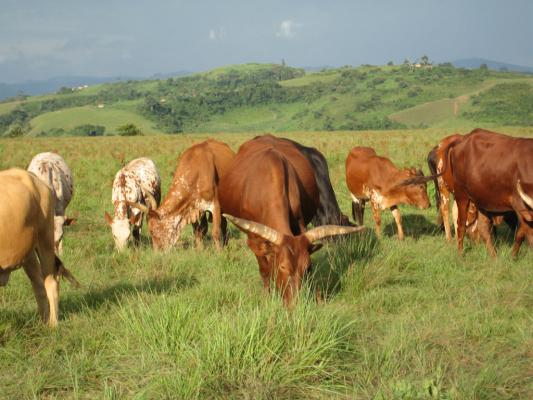A Hidden War In DRC, Burundi Crisis And Great Lakes Geopolitics
The Great Lakes region is rattled by yet another armed conflict. The fighting has stayed under the international radar, but could broaden and threathen whatever uneasy arrangements for peace or stability might be in place. Alex Ntung takes us up the High Plateaus in South Kivu and into the deep roots of recent violence there.
In the Democratic Republic of the Congo (DRC), over the last three months heavy armed conflict has been engulfing the High Plateau of Itombwe in South Kivu, the homeland of Banyamulenge people, as well as areas bordering Burundi along Rusizi river in the territory of Uvira. The Gumino armed group is currently embroiled in fighting with the Armed Forces of the Democratic Republic of the Congo (FARDC), causing death, forced displacement, and physical and economic insecurity.
This fighting adds further dimensions to a brutal and deepening military and political crisis in Burundi that could violently ripple across the Great Lakes
Beyond the largely unresolved conflicts that continued to flare after the North Kivu conflict and March 23 Movement insurgency (M23 rebellion), this fighting adds further dimensions to a brutal and deepening military and political crisis in Burundi that could violently ripple across the Great Lakes region if appropriate peaceful actions are not considered soon.
The high plateaus of Itombwe and Ruzizi areas are strategic regional places for security where there is a strong presence of armed groups, including local ethnic militias groups. In the last three months, the recent political crisis in Burundi has triggered attacks on many villages in the Ruzizi plain, with looting and the arbitrary arrests of members of local Banyamulenge cattle herding communities, a Congolese Tutsi ethnic group. Herders are accused of supporting Burundi-armed opposition groups in the DRC, and having possible links with Rwanda’s intelligence services.
The fighting between Gumino and FARDC has taken many by relative surprise and raises many questions: who are the Gumino? Why has FARDC decided specifically to target the Gumino? Why is the Gumino leader, Colonel Richard Tawimbi, well protected by the President Joseph Kabila? Why is FARDC not interested in eradicating other armed groups such as the Mai Mai militias groups of General Amuri William Yakutumba, Mupekanya (a coalition of local ethnic groups in South Kivu), the National Forces of Liberation formerly Party for the Liberation of the Hutu People (FNL) which uses DRC’s South Kivu province as a fallback base, and the Forces Démocratiques pour la Libération de Rwanda (FDLR) - the rebel group led by remnants of those who carried out the genocide in Rwanda in 1994?
This is the first impact of the deteriorating political crisis in Burundi causing cross-border ethnic violence, with wider implications for the regional stability. The FARDC military intervention also demonstrates that military response seems motivated not by whether an armed group is harmful and threatening to the local population, but whether it would be hostile to the Kinshasa government and the Southern Africa Development Community (SADC)’s interests in the DRC, or indeed if any armed conflict is perceived as being supported by external powers such as Rwanda.
Who are the Gumino militia group?
The Gumino has been a major resistance force to the Mai Mai militia group of General Amuri William Yakutumba, whose venomous and xenophobic ideology aims to wipe out those perceived as ‘non-native’ or Congolese Tutsi from the DRC map. The Gumino identifies itself with the Front Republicains Federalistes (FRF), one of over 400 Congolese political parties. In terms of ‘patriotic’ ideology, ‘Gumino’ means ‘we are here to stay’; ‘we will not leave this place’.
In terms of ‘patriotic’ ideology, ‘Gumino’ means ‘we are here to stay’; ‘we will not leave this place’.
In the absence of any state authority, to ensure the security of defenceless civilians, the high plateaus have often been a closed military area defended by the Banyamulenge themselves, without the control of either the Congolese government or other armed groups. The Gumino is a product of post-independence conflicts which have tragically affected the area, resulting in the politicisation and militarisation of ethnic tensions, and the recurrence of nationalist armed groups.
Historically, groups with such ideologies have been referred to as Abagiriye (guerrillas): volunteers from the local Banyamulenge community whose role was to protect the area against rebels and government forces. Both are paramilitary groups, the only difference being that the Abagiriye were not militarily trained and did not defect from the army.
Following the Congo Second War in 1998, South Kivu was transformed into a patchwork of militia fiefdoms mainly driven by micro-level ethnic hatreds. In rural areas, due to inaccessibility and the near total absence of state authority, violence is part of everyday life: under-reported and under-researched.

In rural areas, due to inaccessibility and the near total absence of state authority, violence is part of everyday life: under-reported and under-researched.
© Alex Mvuka Ntung
The Gumino arose as the modern Abagiriye following the 2002 Sun City peace agreement between the government and some rebels. President Joseph Kabila signed a partial agreement with the Rally for Congolese Democracy–Goma’s (RCD-Goma) rebel faction, which was boycotted by some Banyamulenge soldiers suspicious of the agreement, stalling the process of disarmament and the integration of the most influential armed groups back into the national army.
In the last 14 years, there have been three Gumino rebellions based in the high plateaus of South Kivu
In the last 14 years, there have been three Gumino rebellions based in the high plateaus of South Kivu – one was led by General Patrick Masunzu and the other by Colonel Michel Rukundwa known as Makanika. Both were reintegrated in the FARDC and offered senior and lucrative military positions. Before the recent crisis in Burundi, like previous Gumino movements, the group was of regional security interest when its leader, Colonel Richard Tawimbi, was considered as vulnerable to being used by some dissidents from the current Rwandan government.
Concerned about such potential developments, the FARDC successfully negotiated to integrate Colonel Richard Tawimbi into the army. However, his troops were not satisfied about the agreement, especially FARDCs’ promise to ensure security of the local population and eradicate other troops such as the Mai Mai and FDRL.
What has triggered the FARDC fighting with the Gumino?
This hidden war is triggered mainly by the political crisis in Burundi: In April 2015, President Pierre Nkurunziza’s decision to run for a third term was demonstrably contested by people in the capital city of Bujumbura, Burundi. As a consequence the country witnessed a failed coup. More than 400 people were killed in targeted assassinations and violent street protests, and more than 200,000 Burundians have fled to neighbouring countries, mainly Rwanda and Tanzania.
As a result, diplomatic relations between Rwanda and Burundi have deteriorated. Burundi has accused Rwanda of supporting rebellion from the refugee population against the contested President Nkurunziza. Rwanda denies this and in turn has accused Burundi of turning a blind eye to, or even encouraging, the presence of members of the FDLR on its territory, which poses a serious threat to Rwandan security. Burundi has ignored this.
President Pierre Nkurunziza is trying hard to stoke ethnic animosities in Burundi, Rwanda and DRC as a last-ditch strategy to retain power.
While the current crisis in Burundi is rooted in politics, it is very clear that President Pierre Nkurunziza is trying hard to stoke ethnic animosities in Burundi, Rwanda and DRC as a last-ditch strategy to retain power. Neighbouring nations Rwanda and Burundi share cultures, ethnicities, language, a shared colonial heritage governed as one Belgian territory, similar historical paths of conflict, and sharing a border means what affects one, affects the other directly.
One of the factors in Rwanda’s transformation has been to seek the removal of the ethnic identities that once tore it apart, eliminating ethnicity from the public sphere. Burundi, on the other hand, has adopted the opposite approach. The contested president, Pierre Nkurunziza, has exhausted all political means and is choosing the dangerous tactic of mobilising Hutu opposition in Burundi, which could have direct implications for Rwanda and drags it into the crisis.
DRC’s response to the Burundi crisis does not seem to be motivated by the diplomatic relationship between the two countries, but to undermine perceived exploitation of the Burundian situation by Rwanda. There is ongoing suspicions of the Burundi and DRC intelligence service about the Gumino’s ‘direct’ link with Rwanda. Rwandan-linked politico-military groups active in eastern parts of the country have always been under greater scrutiny by the DRC government, which sees them as potentially hostile to Kinshasa’s power.
President Kabila is struggling to handle threats from the opposition and the population, who are opposing a draft law that would allow him to extend his stay in power beyond his current mandate, ending in December 2016. With the international community considering him a ‘necessary evil’, President Kabila has taken the opportunity to propose an ‘inclusive national political dialogue’.
He has said that all actors in leadership (the government, opposition, civil society and religious groups) should come together and reach an agreement on key challenges such as the electoral calendar, updating the register of voters, and how to finance the elections. In this process, the Congolese Tutsi (especially the Banyamulenge) political class in Kinshasa sees itself outside the influential debate.
To win the President Kabila’s attention, those ‘queuing’ for government senior positions have to demonstrate their ‘influence’ at the grassroots level
To win the President Kabila’s attention, those ‘queuing’ for government senior positions have to demonstrate their ‘influence’ at the grassroots level, and loyalty to his government. In this context, Gumino was raised as ‘an emerging security threat’ by some members of the Congolese Tutsi in Kinshasa.
As Gumino has collaborated with the FARDC, a peace negotition was offered by Colonel Albert Mutumwa Munyamahoro and Major Amoni Mutabazi Kanyabu. The negotiations failed and ledto fighting in the villages of Kajembwe, Murambya and Mugeti. Unexpectedly, FARDC was dealt a serious blow with an ambush by the ’Gumino’ that killed the FARDC commandant, Major Ruhorimbere Rutaganda.
Why does the FARDC dislike the Gumino?
For an armed group to be of interest for the FARDC to target, it seems it would be politically influential and hostile to the government, with the ability to control territory, or be exploited by an opposition political party. On the point of capacity for exploitation, the group also seemingly needs to be ‘Tutsi’ led and perceived to have ‘potential to receive support from neighbouring countries such as Rwanda or Uganda’.

The Mai Mai carry out large-scale attacks on civilians, in which rape is used as a weapon of war
© Alex Mvuka Ntung
FARDC may also target if the group is of western powers interest which could put President Kabila under political pressure and expose his army’s failures in protecting innocent civilians. Lastly, the group needs to be weak enough to be defeated by FARDC, which could greatly strengthen President Kabila’s position domestically.
The Mai Mai carry out large-scale attacks on civilians, in which rape is used as a weapon of war
The Mai Mai militia groups under General Amuri William Yakutumba, mainly from Babembe ethnic groups, from Mupekanya (a coalition of local ethnic groups), and the FDLR have had a long-standing aim to kill and destroy those perceived to be ‘unwanted’ or of Tutsi ethnic group. The Mai Mai have carried out, and continue to carry out, large-scale attacks on civilians, in which rape is used as a weapon of war, systematically torturing children and women in particular.
Some of the Mai Mai militia members were demobilized after the Second Congo War (1998–2003), and their leaders were honoured with lucrative senior military and government positions in the hope that their troops would be integrated. Just a week before the fighting between the FARDC and Gumino, a coalition of Mai Mai operating in the Bijombo area suggested to the government that they would like to be demobilised and integrated with the FARDC, and offered to give up their arms. FARDC failed to facilitate this process. For the FARDC, despite the ongoing killing of innocent people, as long as the Mai Mai are not a security interest or hostile to President Kabila, they are ostensibly being considered as future ‘security asset’ and therefore as a low priority.
The FDLR problem has become more of a political issue than a military one. Rwanda and DRC’s volatile diplomatic relations have shifted from bad to worse in recent times, with suspicions growing following the defeat of the M23 by the UN Forces Integration Brigade (UNFIB) led by Tanzania and South Africa.
The former M23 rebels were not reintegrated in the FARDC, and are considered a potential threat to the DRC
The former M23 rebels were not reintegrated in the FARDC after this defeat, and while receiving political exile in Uganda, they are considered a potential threat to the DRC. President Kabila is engaged in a political and security power struggle with Rwanda. As regional powers, Rwanda and Uganda are pushing hardest for military action against the FDLR. The FIB on the other hand sees the group as ‘low priority’ with no direct challenge to SADC interests in DRC and Kabila’s authority in the way that M23 was.
There is an exception: the current joint military action between FARDC and Burundi armed forces to fight the Burundian opposition militias of the FNL can be seen as an indirect trading of political interests. While Burundi isn’t threatening to President Kabila, South SADC members (South Africa and Tanzania) remain committed to protecting their political and economic interests in DRC and supporting Burundi.
Beyond important trade agreements with DRC, SADC has been significantly involved in expand its influence through defense and security sectors and use these as structures to demonstrate its ability to act as peace-maker in the Great Lakes Region of Africa. FNL fighters have created bases in South Kivu from which to launch attacks on Burundi’s army. Such a security threat cannot be tolerated by South Africa and Tanzania, given their relationship with Burundi and interests in the DRC.
The Gumino and the Great Lakes geopolitics
The UNFIB’s official mission was to carry out offensive operations, either unilaterally or jointly, with the Congolese armed forces to end the M23, the FDLR, the Lord’s Resistance Army (LRA) and all other armed groups acting in the region. The FIB’s key objectives remains to stop both Rwandan expansion and EAC influence in DRC. The victory over M23 was a major shift in regional power relations.
In the last three years, relations between Rwanda and Tanzania, under President Jakaya Kikwete, have been seriously difficult, leading to wars of words and insults, which were mounting to a potential conflict. The newly elected president of Tanzania, John Pombe Joseph Magufuli, has provided hope for future dialogue and co-operation between the two countries. While this is positive diplomatically, Tanzania’s institutions, structures and relationship with the SADC and Burundi will not change during the five-year term of President Magufuli.
With growing enemies, Rwanda’s major concern is to limit its isolation
With growing enemies, Rwanda’s major concern is to limit its isolation, and it has already taken steps such as the mutual defence agreement with Uganda and Kenya following the M23 defeat. Other countries, such as South Sudan, undergoing its own conflict crisis, has recently joined the EAC, and there is growing interest surrounding Ethiopia’s future integration.
A soft shift in Tanzania’s focus from the SADC to EAC means its ties with Burundi will remain neutral and facilitative. Consequently the FARDC will seek to suppress any influential armed group with the potential to hinder SADC’s trade agreements and political and defense commitment since its intervention in the Second Congo War in 1998. While SADC and other international powers may wish President Pierre Nkurunzia to go, Rwanda’s influence in the region is viewed as a more concerning imperative than security issues in Burundi.

With growing enemies, Rwanda’s major concern is to limit its isolation
© Alex Mvuka Ntung
Conclusions
The Burundi crisis will continue to cause ethnic violence with wider regional implications: it is happening at a most unstable time in the region, and in the DRC in particular, where the ended M23 rebellion and other conflicts remain unresolved, and in face of continuing and competing external interests fuelling the current conflicts.
Any long-term armed group solution must cease to offer incentives to rebels to lay down arms in exchange for senior military and economic positions
What is driving FARDC’s decision to combat a specific armed group is to sustain such divides and protect SADC interests in DRC. International efforts to resolve the conflict in Burundi must directly involve DRC and Rwanda, and avoid a ‘firefighting’ intervention mechanism based on ethnic ‘lenses’ that other conflict responses in the region have followed, and encompass a nuanced understanding of the wider context.
The FARDC and the United Nations Organization Stabilization Mission (MONUSCO) must enforce the rule of law and assure the safety of defenceless civilians across the whole DRC territory. They must work together in good faith to stop violent conflict and the development of militia ideologies in the high plateaus of Itombwe.
Any long-term armed group solution must cease to offer incentives to rebels to lay down arms in exchange for senior military and economic positions. All regional allies and international powers involved in DRC must seek to prioritise peace over their competing political and economic interests, and work together to eradicate the underlying causes of conflict and the recurrence of armed groups in DRC.
Alex Ntung is an author, guest lecturer (conflict studies), professional member of the UK Expert Witness Institute, a DRC analyst and expert on the Great Lakes Region of Africa. Twitter: @AlexMvuka
Maak MO* mee mogelijk.
Word proMO* net als 2790 andere lezers en maak MO* mee mogelijk. Zo blijven al onze verhalen gratis online beschikbaar voor iédereen.
Meer verhalen
-
Report
-
Report
-
Report
-
Interview
-
Analysis
-
Report












 Oxfam België
Oxfam België Handicap International
Handicap International